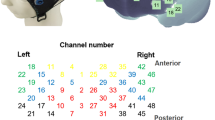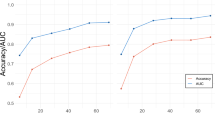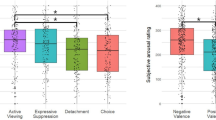Abstract
The emotional counting Stroop (ecStroop) is an emotional variant of the counting Stroop. Both of these tasks require a motor response instead of a spoken response for the purpose of minimizing head movement during functional MRI (fMRI). During this task, subjects report, by button press, the number of words (1–4) that appear on a screen, regardless of word meaning. Neutral word-control trials contain common words (e.g., 'cabinet' written three times), while interference trials contain emotional words (e.g., 'murder' written three times). The degree to which this task represents a true 'Stroop' interference task, in the sense that emotional words will increase motor-response times compared with neutral words, depends upon the subjects of the study and the words that are presented. Much research on the emotional Stroop task demonstrates that interference effects are observed in psychopathological groups in response to words that are specific to their disorder, and in normal subjects when the words are related to current concerns endorsed by them. The ecStroop task described here will produce reaction time-interference effects that are comparable to the traditional color-naming emotional Stroop. This protocol can be completed in ∼20 min per subject. The protocol described here employs neutral words and emotional words that include general-negative words, as well as words specific to combat-related trauma. However, this protocol is amenable to any emotional word lists.
This is a preview of subscription content, access via your institution
Access options
Subscribe to this journal
Receive 12 print issues and online access
$259.00 per year
only $21.58 per issue
Buy this article
- Purchase on Springer Link
- Instant access to full article PDF
Prices may be subject to local taxes which are calculated during checkout


Similar content being viewed by others
References
Stroop, J.R. Studies of interference in serial verbal reactions. J. Exp. Psychol. 18, 643–662 (1935).
Mathews, A.M. & MacLeod, C. Cognitive approaches to emotion and emotional disorders. Ann. Rev. Psychol. 45, 25–50 (1994).
McNally, R.J. et al. Selective processing of threat cues in posttraumatic stress disorder. J. Abnorm. Psychol. 99, 398–402 (1990).
Whalen, P.J. et al. The emotional counting Stroop paradigm: a functional magnetic resonance imaging probe of the anterior cingulate affective division. Biol. Psychiatry 44, 1219–1228 (1998).
Bush, G., Luu, P. & Posner, M.I. Cognitive and emotional influences in anterior cingulate cortex. Trends Cogn. Sci. 4, 215–222 (2000).
Williams, J.M.G., Mathews, A. & MacLeod, C. The emotional Stroop task and psychopathology. Psychol. Bull. 120, 3–24 (1996).
Donaldson, D.I. & Buckner, R.L. in Functional MRI: An Introduction to Methods (eds. Jezzard, P., Mathews, P.M. & Smith, S.M.) 177–195 (Oxford University Press, Oxford, UK, 2001).
Ollinger, J.M., Corbetta, M. & Shulman, G.L. Separating processes within a trial in event-related fMRI. Neuroimage 13, 210–217 (2001).
Kaspi, S.P., McNally, R.J. & Amir, H. Cognitive processing of emotional information in posttraumatic stress disorder. Cognit. Ther. Res. 19, 319–330 (1995).
Zarahn, E., Agguire, G. & D'Esposito, M. A trial-based experimental design for fMRI. Neuroimage 6, 122–138 (1997).
Oldfield, R.C. The assessment and analysis of handedness: the Edinburgh Inventory. Neuropsycholgia 9, 97–113 (1971).
Shin, L.M. et al. An fMRI study of anterior cingulate function in posttraumatic stress disorder. Biol. Psychiatry 50, 932–942 (2001).
Chemtob, C.M. et al. The Honolulu posttraumatic stress disorder stimulus set. J. Trauma. Stress 10, 337–343 (1997).
McNally, R.J. et al. Sensitivity to stress-relevant stimuli in posttraumatic stress disorder. J. Anxiety Disord. 1, 105–116 (1987).
Devinsky, O., Morrell, M.J. & Vogt, B.A. Contributions of anterior cingulate cortex to behaviour. Brain 118, 279–306 (1995).
Vogt, B.A., Finch, D.M. & Olson, C.R. Functional heterogeneity in cingulate cortex: the anterior executive and posterior evaluative regions [review]. Cereb. Cortex 2, 435–443 (1992).
Bush, G. et al. The counting Stroop: an interference task specialized for functional neuroimaging — validation study with functional MRI. Hum. Brain Mapp. 6, 270–282 (1998).
Acknowledgements
This research was supported by NIMH (16259 and 01215) and NARSAD. Preparation of this manuscript was supported by NIMH (069315).
Author information
Authors and Affiliations
Corresponding author
Ethics declarations
Competing interests
The authors declare no competing financial interests.
Rights and permissions
About this article
Cite this article
Whalen, P., Bush, G., Shin, L. et al. The emotional counting Stroop: a task for assessing emotional interference during brain imaging. Nat Protoc 1, 293–296 (2006). https://doi.org/10.1038/nprot.2006.45
Published:
Issue Date:
DOI: https://doi.org/10.1038/nprot.2006.45
This article is cited by
-
Neuroimaging and artificial intelligence for assessment of chronic painful temporomandibular disorders—a comprehensive review
International Journal of Oral Science (2023)
-
Neural activation during emotional interference corresponds to emotion dysregulation in stressed teachers
npj Science of Learning (2022)
-
Improving Emotion Regulation, Well-being, and Neuro-cognitive Functioning in Teachers: a Matched Controlled Study Comparing the Mindfulness-Based Stress Reduction and Health Enhancement Programs
Mindfulness (2022)
-
Identifying Specific Emotion Regulation Deficits that Associate with Nonsuicidal Self-injury and Suicide Ideation in Adolescents
Journal of Youth and Adolescence (2022)
-
The neuro-pathophysiology of temporomandibular disorders-related pain: a systematic review of structural and functional MRI studies
The Journal of Headache and Pain (2020)
Comments
By submitting a comment you agree to abide by our Terms and Community Guidelines. If you find something abusive or that does not comply with our terms or guidelines please flag it as inappropriate.



